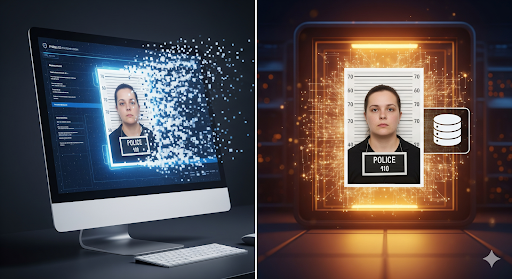Once a mugshot is deleted, the problem is solved. The truth is, the digital world doesn’t work that way. Images can take on a life of their own — copied, indexed, and re-posted in places you’ve never heard of.
Even after the source removes the image, third-party “mugshot zone” databases can keep it alive, ready to resurface in search results at any time. For someone trying to rebuild a personal or professional reputation, this can feel like a bad chapter that refuses to end.
Mugshot databases collect and post publicly available arrest information, often including booking photos, charges, and arrest dates. Once uploaded, that content can be copied into other databases, creating a ripple effect across the internet.
What starts as a single record in one location can quickly multiply, appearing on multiple websites with no direct connection to the original posting. And because these databases are built for visibility, they’re often well-optimized to rank in search results.
While some claim these sites serve public transparency, the reality is that they can have lasting consequences for people who were never convicted or whose cases were dismissed entirely.
Deleting a mugshot from one site is often just the first step — and sometimes, it’s barely a step at all. Once an image has been scraped or mirrored by other databases, those copies operate independently.
Someone searching your name might not see the original site, but they’ll see the same photo on another platform. The same caption. The same charges. The same negative impression.
This is where most people realize the real battle isn’t just removing one image — it’s breaking a chain of re-posts that can stretch across dozens of domains.
- Automated Data Scraping
These databases often pull arrest information directly from public records. If your arrest record is still available in a government database, there’s a good chance it will keep being re-published. - Search Engine Indexing
Once an image is indexed, search engines can store it for months — sometimes years — even if the original page is gone. - Cross-Posting Between Sites
Mugshot zones often trade or share data. Removal from one site doesn’t guarantee removal from its network.
When these images live on in third-party databases, the damage can be immediate and personal:
- Job Opportunities Lost – Employers often search for candidates online before interviews. One outdated mugshot can outweigh a decade of professional achievements.
- Strained Relationships – Friends, colleagues, or clients may stumble across the image without knowing the full story.
- Ongoing Anxiety – The constant fear that a new site will publish the image again can make it feel impossible to fully move on.
Removing mugshots from third-party databases isn’t just about sending one email. Common obstacles include:
- Different Laws by State or Country – Your removal rights can change depending on where you live.
- Non-Compliance – Some sites simply ignore removal requests unless they’re backed by legal action.
- Reappearance – Even after a successful removal, the same image can reappear when another site scrapes the same public data.
This is why many people turn to online reputation management firms like NetReputation, which specialize in tracking these appearances and using both legal and SEO-driven approaches to control visibility.
- Track Where Your Mugshot Appears
Begin by conducting a thorough search of your name in both standard and image search engines. Keep a record of every site hosting the image. - Submit Removal Requests
Follow the instructions provided by each site. Be clear, concise, and keep copies of all communications. - Address the Source Data
Work to have the original public record sealed or removed. This prevents future reposting. - Build a Strong Positive Presence
Publish professional images, content, and profiles so that positive results can compete with or outrank negative ones. - Consider Professional Help
A coordinated approach — legal, technical, and reputational — is often the fastest path to lasting results.
Public pressure and legal reform are slowly changing the landscape. Some states have introduced laws to prevent sites from charging removal fees or to limit public access to certain arrest records. Advocacy groups continue to push for stronger privacy protections.
Until those changes become widespread, anyone with a mugshot online needs to approach the problem strategically — not just with one deletion request, but with an ongoing plan to monitor, remove, and replace harmful results.
Because in the digital age, a photo isn’t just a photo. It’s a headline, a search result, and a first impression — and unless you control where and how it appears, it can define you for far longer than it should.
Keep an eye for more latest news & updates on News Ross!
